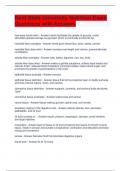Kent State University Nutrition Exam
Questions with Answers
how does insulin work - Answer-insulin facilitates the uptake of glucose. it also
stimulates glucose storage as glycogen which is eventually turned into fat.
insoluble fiber examples - Answer-whole grain wheat flour, bran, seeds, carrots,
insoluble fiber does what - Answer-increase real weight and volume. prevent/alleviate
constipation.
soluble fiber examples - Answer-oats, barley, legumes, rice, soy, fruits.
soluble fiber does what - Answer-makes a gel-like substance, softens fecal matter and
reduces strain, reduces blood cholesterol, promotes satiety, lowers blood sugar, and
promotes the growth of good bacteria in the colon.
epithelial tissue example - Answer-mucosa
epithelial tissue definition - Answer-tissue that forms protective layer on bodily surfaces
and lines internal organs, ducts, and cavities.
connective tissue definition - Answer-supports, connects, and anchors body structures,
"glue"
connective tissue examples - Answer-submucosa and serosa
neural tissue - Answer-tissue making up brain, spinal cord, and nerves.
accessory organs of the digestive tract - Answer-salivary glands, liver, pancreas,
gallbladder, and GI tract
GI tract consists of.. - Answer-mouth, pharynx, esophagus, stomach, small intestine,
and large intestine.
muscularis - Answer-layer of tissue in GI tract containing two layers of smooth muscle
tissue. inside in circular and outside is longitudinal. contraction and relaxation promotes
mixing and movement.
serosa - Answer-Secretes fluid that lubricates digestive organs
transit time - Answer-24 to 72 hours
, three phases of digestion: - Answer-cephalic, gastric, intestinal
what is cephalic phase - Answer-before food enters mouth
gastric phase - Answer-arrival of food in stomach
secretions needs for digestion - Answer-mucus, saliva, enzymes (biological catalysts),
GI hormones, bile, pancreatic juice, and gastric juice.
regulation of GI motitility - Answer-Neural Regulation and hormonal regulation
functional foods. - Answer-neutraceuticals
functional foods. - Answer-foods that have been modified to enhance their contribution
to a healthy diet.
phytochemicals are located - Answer-in plants.
phytochemicals can... - Answer-provide color, flavor, growth, protection, some assist in
the energy making process, act as hormones, serve as antioxidants, block/neutralize
enzymes, modify absorption/production/utilization of cholesterol, and decrease blood
clots.
list macronutrients: - Answer-carbs, proteins, fats, and water
calories per gram of carb or protein? - Answer-4
calories per gram of fat - Answer-9
list micronutrients: - Answer-vitamins and minerals.
chronic diseases are caused by - Answer-faulty diets.
Irradiated foods - Answer-odd food additive. use X-rays, gamma rays, and electron
beams to kill microorganisms in the food.
benefit of irradiated foods - Answer-enhance shelf life and decrease food borne illness.
food additives are - Answer-substances added to foods to change flavor, color, texture,
shelf life, or nutrient content.
food additives are most commonly - Answer-salt and sugar.
what percent of DV is low. - Answer-5% or less
what percent of DV is high - Answer-20% or more




